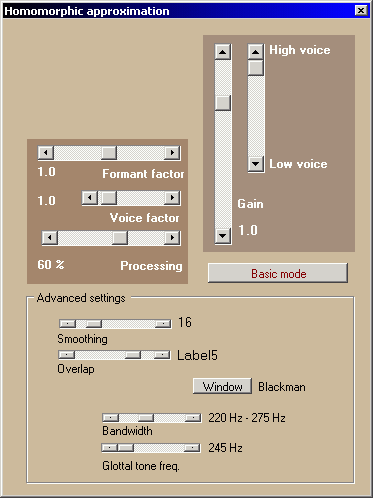Multitask Noisy Speech Enhancement System
www.denoise.net
Example
Restorer
- Speech band equalizer
- Dynamics processing
- Noise gate
- Signal level limiter
- Clipping restoration
- Noise reduction
- Noise whitening
- Blind deconvolution
- Spectrum analyser
- Time stretching
- Spectral expander
- Fourier corrector
- Neural network corrector
- Decorrelation
- Joint approximation
- Homomorphic approximation
- Reverberation
Recorder
Browser
- Synchronisation
- Normalisation
Contact info
Homomorphic approximation
The homomorphic approximation module enhances speech intelligibility by modifying signal spectrum using the results of cepstral analysis of the signal. The spectrum envelope of the signal is usually distorted due to noise and distortions. The homomorphic approximation restores spectrum envelope of the typical speech signal. The homomorphic approximation module should be used after the signal is processed by other modules.
It is known that in speech signal, low cepstral components describe the spectrum envelope and they are related to the vocal tract shape, while the high cepstral components are related to the excitation signal (only for voiced consonants and only in the narrow frequency range), which depends on the glottal tone frequency. Other cepstral components are not important and may be removed, so that resulting spectrum envelope of the speech signal is obtained.
After the cepstral smoothing of the signal spectrum is performed, it is possible to determine the values of the parameters related to the vocal tract shape: formant frequencies and formant levels. Cepstral components related to the spectrum envelope (indices 0 to K) and components related to the excitation (indices R to S) are used for resynthesis of the speech signal:
![]()
The equation above describes the selective spectrum, obtained by selecting only the desired cepstral components. The homomorphic approximation is performed using the transform:

where x(n) is the original signal and v(n) is the signal processed using the homomorphic approximation procedure. The restored signal is obtained by calculating the inverse Fourier transform of the approximation results.
The main parameters of the algorithm that may be set by the user in the module window are formant factor (vocal tract shape) and voice factor (glottal tone). Value equal to 1.0 means that this parameter does not affect the processed signal. The frequency range used in cepstral analysis may be set using the 'low voice - high voice' slider. Additional parameters are: gain, glottal tone frequency, bandwidth, smoothing factor, time weighting window and overlap length.
